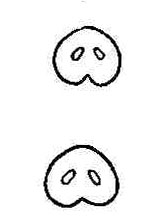|
Hardy Fern Home C. bulbifera resources All Ferns � Woodsiaceae �� Cystopteris
�Other Genera
|
| Cystopteris bulbifera | ||
Bulblet bladder fern, Berry bladder fern | ||
|
Etymology
Bulbifera means bearing bulbs, or in this case, bulblets.
Description
Rhizome: short-creeping, covered with old stipe bases, scales tan to light brown, lanceolate, somewhat clathrate.
Frond: 75 cm high by 15 cm wide, deciduous, monomorphic, but early fronds smaller, sterile, less divided, blade/stipe ratio: 2:1 to 4:1. Stipe: stipes --3 to 8-- clustered at stem apex, grooved, maroon/reddish when young, straw-colored to green above, sparsely scaly at base, vascular bundles: 2, round or oblong. Blade: 2-pinnate-pinnatifid, narrowly triangular, widest at base, arching, bearing bulblets on the rachis (or sometimes the costa) one-third back from the apex, herbaceous, light green or yellowish-green, rachis and costae usually densely covered by gland-tipped hairs, often with bulblets, axils of pinnae occasionally with gland-tipped hairs. Pinnae: 18 to 25 pair, perpendicular to the rachis, � opposite, lanceolate; costae grooves above continuous from rachis to costae; margins serrate; veins free, simple or forked, directed to notches. Sori: round, in 1 row between midrib and margin, indusium: cup-shaped, beneath sorus on midrib side, on a vein, sporangia: brown to black, maturity: midsummer to early fall. Culture
Habitat: cracks and ledges on cliffs, rarely terrestrial; usually on calcareous substrate.
Distribution: central and eastern North America, disjunct in southwesten N.A..
Hardy to -35�C, USDA Zone 3.
Distinctive Characteristics
The bulblets are common on mature fronds, distinguishing this from all other Cystopteris except C. laurentiana, where they are rare. The maroon stipe on young fronds is also unshared with other Cystopteris, once again with the exception of C. laurentiana. Perhaps you are getting the impression this is a parent of C. laurentiana, and you would be right.
Synonyms
Polypodium bulbiferum Linnaeus |
|
|
Notes
Compare to C. laurentiana is the most similar species, having only occasional bulblets, and is widest above the base vs. at the base here. The venation differs also, with veins extending both to the teeth tips and to the notches.
Hybrids C. tennesseensis and C. illinoensis are other hybrids stemming from C. bulbifera. Neither is reported in cultivation.
Compare to C. laurentiana is the most similar species, having only occasional bulblets, and is widest above the base vs. at the base here. The venation differs also, with veins extending both to the teeth tips and to the notches.
Hybrids C. tennesseensis and C. illinoensis are other hybrids stemming from C. bulbifera. Neither is reported in cultivation.

Cystopteris bulbifera. Two oblong vascular bundles at 90� throughout the length of the stipe. �Drawing from Ferns of Northeastern United States, Farida A. Wiley, 1936. |